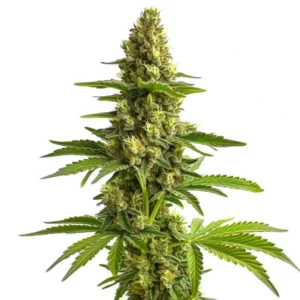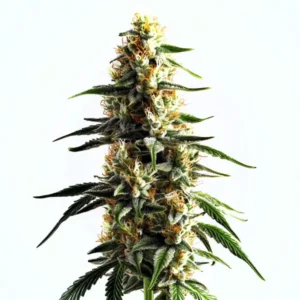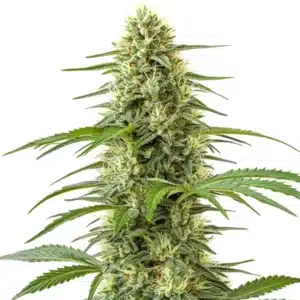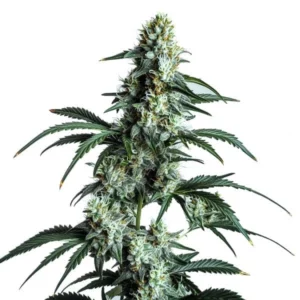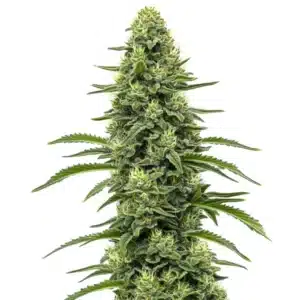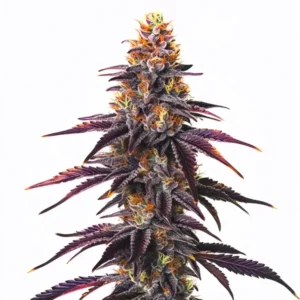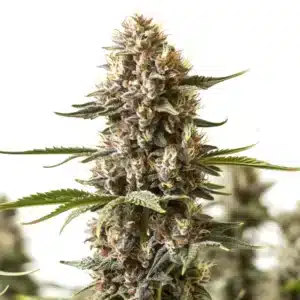
Transpiration Rate and Its Effect on Cannabis Yield
Transpiration is a vital process for cannabis plants. It’s how water moves from the roots, through the plant, and out into the air. This movement is essential for nutrient uptake and temperature regulation. Knowing the transpiration rate and its effect on cannabis yield is crucial, since balanced water loss directly impacts nutrient absorption, growth efficiency, and the overall quality of your harvest.
The transpiration rate is the speed at which water vapor is lost from the plant. This rate can have significant implications for cannabis growth and yield. If you’re looking to maximize your harvest, knowing transpiration is key.
Recommended Strains
Bruce Banner #3
|
|
THC | 20% - 29% (High) |
|
|
Type | Feminized |
|
|
Yield | Medium |
|
|
Phenotype | 50% Indica / 50% Sativa |
Girl Scout Cookies
|
|
THC | 18% - 25% (Medium) |
|
|
Type | Feminized |
|
|
Yield | High |
|
|
Phenotype | 60% Indica / 40% Sativa |
Controlling the environment to maintain the optimal transpiration rate for cannabis yield is crucial. Factors like temperature, humidity, and airflow all play a part. With the right balance, your plants can thrive, leading to a more bountiful harvest.
How Transpiration Rate Affects Cannabis Growth
The process of transpiration impacts more than just water movement. It’s directly tied to nutrient distribution within the plant. When water evaporates from leaf surfaces, it creates a suction force. This pulls water and nutrients up from the roots.
Without appropriate transpiration, nutrient deficiencies can occur. This can stunt growth and lower yields. By managing the transpiration rate, growers can ensure that cannabis plants receive the nutrients they need.
Besides to nutrient uptake, the transpiration process aids in cooling the plant. As water evaporates, it helps maintain a stable internal temperature, which is crucial for cellular functions. This cooling effect is particularly important in preventing heat stress, especially during peak sunlight hours.
The transpiration rate and its effect on cannabis yield cannot be overstated. When plants transpire efficiently, they are less prone to stress and more capable of developing robust structures. This ensures that the resources are directed towards producing dense, resinous buds rather than merely surviving.
Temperature and Humidity Control
Temperature and humidity are linked closely to the transpiration rate. High temperatures can increase transpiration, leading to potential water stress. On the other hand, low temperatures might slow it down, reducing nutrient uptake.
Humidity also plays a significant role. High humidity levels slow down transpiration because the air is already saturated with moisture. Conversely, low humidity can speed it up, potentially drying out the plant.
To maintain the optimal transpiration rate for cannabis yield, growers must fine-tune their environmental controls. This involves regular monitoring and adjusting of temperature and humidity levels to match the specific needs of their cannabis strain.
Advanced growers often employ automated systems to regulate these conditions, ensuring a consistently ideal environment. Such precision not only improves plant health but also increases the overall efficiency of the growing operation, leading to better yields. Knowing the transpiration rate and its effect on cannabis yield is also crucial, as proper water movement through the plant directly influences nutrient uptake, bud size, and final harvest quality.
Cannabis Yield Improvement Through Transpiration Management
Managing the transpiration rate can lead to substantial improvements in cannabis yield. By ensuring that conditions are optimal, plants can focus energy on growth rather than survival.
Consider the strain “Bruce Banner 3” from Blimburn Seeds. This strain thrives in well-managed environments where the transpiration rate is just right. It rewards growers with high yields and potent buds.
Effective transpiration management involves more than environmental tweaks; it also requires careful observation of plant responses. By learning to read these signals, growers can make informed decisions that favor yield enhancement.
The cannabis yield improvement through transpiration management is a testament to a grower’s ability to harmonize various growth factors. As growers master this balance, they unlock the potential to cultivate healthier, more productive plants.
Promos & Deals
Impact of Leaf Transpiration on Cannabis Production
Leaf transpiration is a small part of a bigger picture. However, its effects on cannabis production are profound. Each leaf acts like a mini pump, moving water and nutrients throughout the plant.
The health of these leaves can indicate how well your plant is transpiring. Look for signs like wilting or yellowing, which might suggest issues with the transpiration rate. Healthy leaves mean a healthy plant, leading to better yields.
Knowing the impact of leaf transpiration on cannabis production involves recognizing the role each leaf plays in the plant’s overall health. Healthy leaves contribute to a robust photosynthesis process, driving growth and development.
Moreover, leaves with optimal transpiration rates are more efficient in gas exchange, which is crucial for maintaining the plant’s metabolic processes. This efficiency translates into higher energy availability for the plant, ultimately supporting greater yields. Knowing the transpiration rate and its effect on cannabis yield helps growers optimize watering, humidity, and airflow to maximize plant performance.
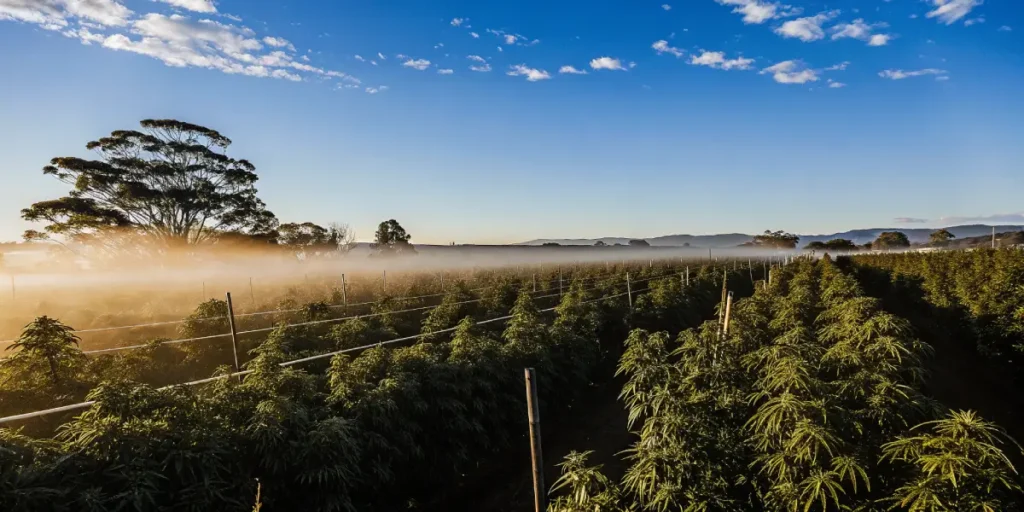
Practical Tips for Managing Transpiration
- Use fans to improve air circulation and maintain optimal humidity.
- Adjust lighting to control temperature and reduce water loss.
- Monitor plant health regularly and adjust conditions accordingly.
- Ensure adequate watering to support the transpiration process.
Managing transpiration isn’t just about the environment. It’s also about choosing the right strains. “Girl Scout Cookies” from Blimburn Seeds is another strain that responds well to precise environmental control.
By following these tips, you can effectively manage transpiration and boost your cannabis production. It’s a science, but with practice, it becomes second nature.
One of the most effective practical tips for managing transpiration involves consistently monitoring environmental data. By keeping detailed records, growers can identify patterns and adjust their practices to maintain optimal conditions.
Additionally, integrating technology like automated climate control systems can significantly enhance the management of transpiration rates. These systems provide precise control over environmental variables, allowing for the fine-tuning needed to optimize cannabis yield.
Relationship Between Transpiration and Cannabis Yield
The relationship between transpiration and cannabis yield is undeniable. Effective transpiration ensures that nutrients are available for growth. This directly impacts the size and quality of your harvest.
Strains like “Sour Diesel” from Blimburn Seeds are known for their high yields. By optimizing the transpiration rate, growers can unlock the full potential of such strains, leading to abundant harvests.
Exploring the relationship between transpiration and cannabis yield reveals the intricate balance between environmental factors and plant physiology. By knowing this relationship, growers can implement strategies that enhance plant vitality and productivity.
Ultimately, mastering the art of transpiration management empowers growers to cultivate cannabis with superior quality and higher yields. This knowledge serves as a cornerstone for achieving success in the competitive world of cannabis cultivation.

FAQs
What is the optimal transpiration rate for cannabis yield?
The optimal transpiration rate for cannabis yield varies based on several factors, including strain and growing conditions. Generally, a balanced rate that allows for efficient nutrient uptake and water movement is ideal. Maintaining the right temperature and humidity levels can support this balance.
Keeping an eye on environmental controls and making necessary adjustments will help maintain this optimal rate. Strains like those from Blimburn Seeds are bred to perform well under a range of conditions, but monitoring is still crucial.
Knowing the optimal transpiration rate for cannabis yield involves experimenting with different environmental conditions and observing plant responses. Each strain may have unique requirements, making customization essential for achieving the best results.
Growers who prioritize the optimal transpiration rate often find that their plants are more resilient, healthier, and capable of producing higher yields. This focus on precision contributes to the overall success and sustainability of the cultivation process.
How do I know if my plants are transpiring correctly?
Signs that your plants are transpiring correctly include healthy, vibrant leaves and steady growth. If leaves appear wilted or discolored, it might indicate issues with the transpiration rate. Regular checks and adjustments can help maintain the right conditions.
Using tools like hygrometers and thermostats can provide real-time data on the growing environment. This information can guide adjustments and ensure your plants are thriving.
Besides to visual inspections, growers can use moisture meters and other diagnostic tools to assess plant health and transpiration efficiency. These tools offer insights that are not always visible to the naked eye.
By combining technology with traditional observation methods, growers can achieve a comprehensive knowing of how transpiration rate affects cannabis growth, leading to more informed cultivation practices.
Can I improve cannabis yield through transpiration management alone?
While transpiration management is critical, it’s not the only factor in improving cannabis yield. It’s part of a comprehensive approach that includes proper lighting, nutrition, and care. All these elements work together to support plant health and productivity.
By focusing on transpiration, you’re addressing a key aspect of plant health. When combined with other best practices, the results can be impressive.
Cannabis yield improvement through transpiration management is most effective when integrated with holistic cultivation strategies. This includes optimizing soil health, implementing pest control measures, and maintaining balanced nutrient levels.
Ultimately, the synergy between these various components creates an environment where plants can thrive, maximizing their genetic potential and resulting in larger, more potent harvests.
What tools can help manage transpiration rates?
Several tools can assist in managing transpiration rates. Hygrometers and thermostats are essential for monitoring humidity and temperature. Fans can improve air circulation, and proper lighting setups can help control environmental conditions.
These tools, when used together, create an environment where cannabis plants can thrive. Investing in quality equipment can pay off in the form of better yields and healthier plants.
Advanced growers often utilize climate control systems that automate environmental adjustments. These systems provide a precise and consistent growing environment, reducing the likelihood of stress and enhancing transpiration efficiency.
Additionally, data loggers can track environmental conditions over time, offering valuable insights into how short-term fluctuations might impact long-term plant health and yield.
Are there specific strains that benefit more from transpiration management?
Certain strains, like “Bruce Banner 3,” “Girl Scout Cookies,” and “Sour Diesel” from Blimburn Seeds, respond exceptionally well to precise environmental control. These strains can produce higher yields when the transpiration rate is effectively managed.
Choosing the right strain for your growing conditions can make a significant difference. By tailoring your approach to the needs of the strain, you can achieve optimal results.
Some strains are naturally more resilient to environmental variations, while others may require meticulous attention to detail. Knowing these nuances allows growers to select strains that align with their capabilities and goals.
The relationship between transpiration and cannabis yield is influenced by genetic predispositions. By leveraging strain-specific knowledge, growers can optimize their cultivation practices for maximum yield potential.


